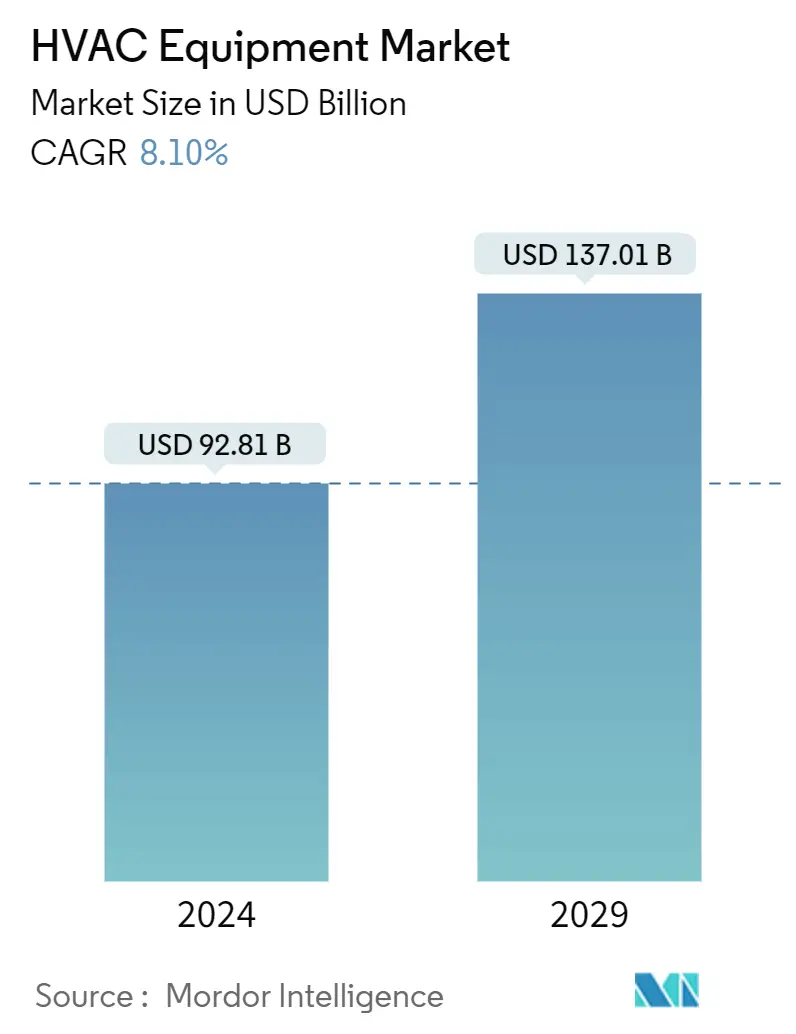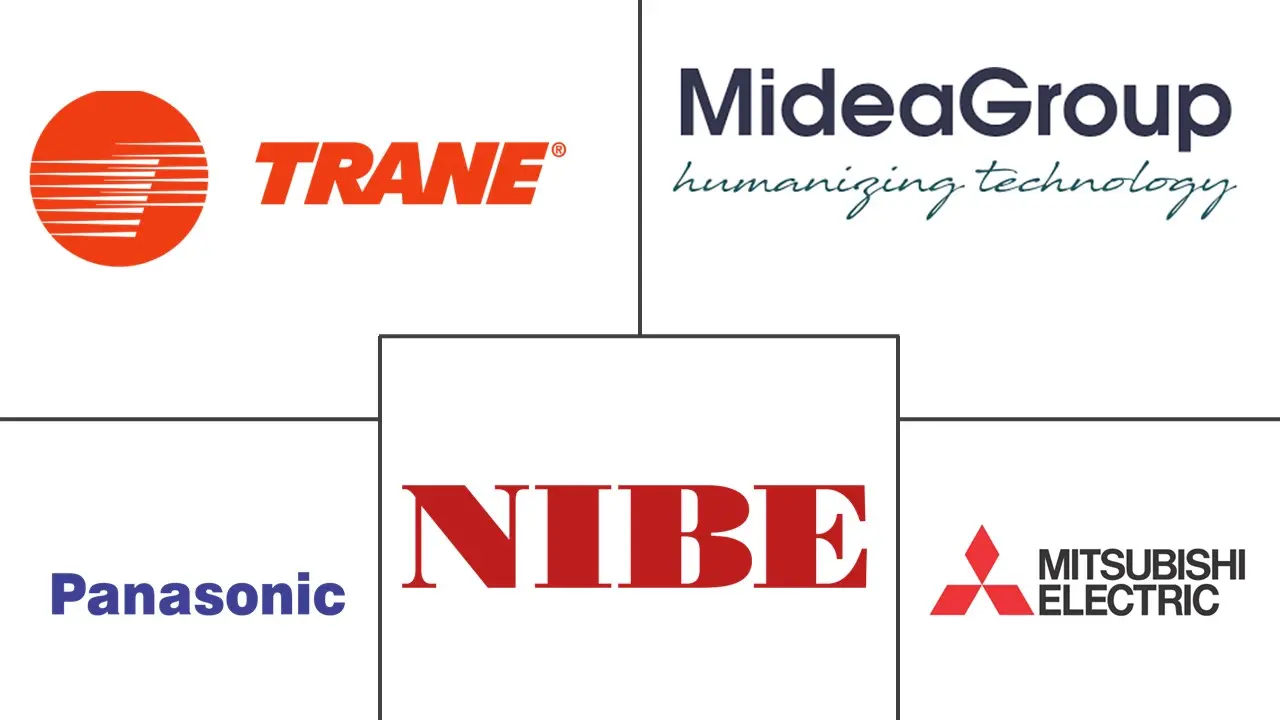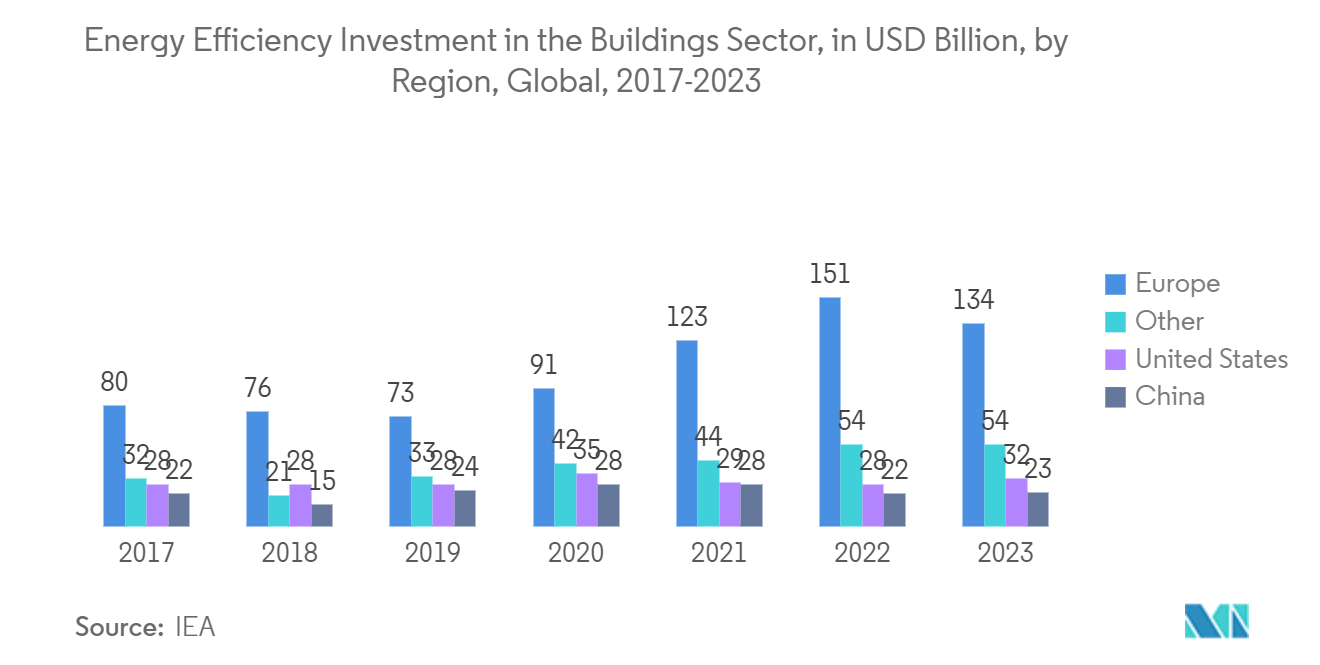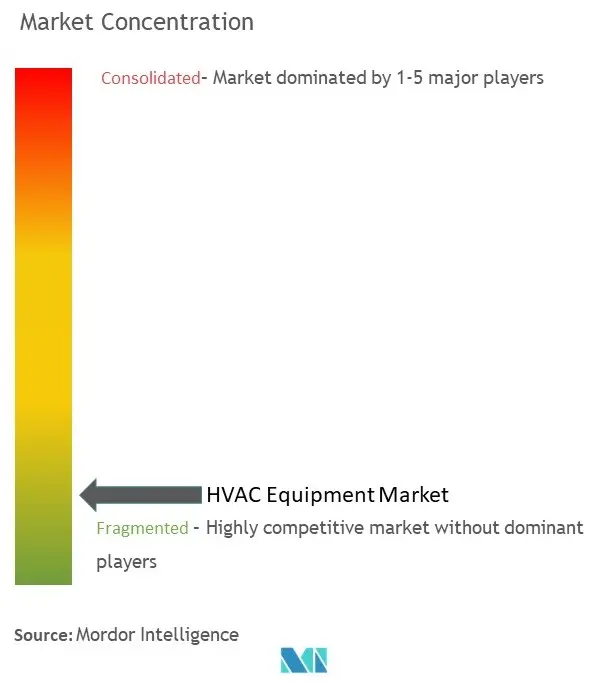HVAC Equipment Market Size

| Study Period | 2019 - 2029 |
| Market Size (2024) | USD 92.81 Billion |
| Market Size (2029) | USD 137.01 Billion |
| CAGR (2024 - 2029) | 8.10 % |
| Fastest Growing Market | Asia Pacific |
| Largest Market | Asia Pacific |
Major Players
*Disclaimer: Major Players sorted in no particular order |
HVAC Equipment Market Analysis
The HVAC Equipment Market size is estimated at USD 92.81 billion in 2024, and is expected to reach USD 137.01 billion by 2029, growing at a CAGR of 8.10% during the forecast period (2024-2029).
HVAC equipment can be applied in a wide range of locations and building types, such as shopping centers, industrial facilities, warehouses, etc., and ensures that a building has proper climate control with heating and cooling along with the necessary air pressure and air quality to make the occupants in the building comfortable and safe.
The rapid rise in industrialization and urbanization worldwide is one of the primary factors driving the market's growth. The movement of people from rural areas to live in towns and cities is one of the most significant population trends of modern times. More than half the world’s population (56.2%) lives in cities today. This trend toward greater urbanization can be seen in all regions of the world but is most pronounced in Latin America and the Caribbean, where more than 80 percent of the population now live in urban areas.
Urbanization looks set to continue to follow this upward curve, with the United Nations predicting that 68% of the global population will live in urban areas by 2050. With the increase in urban population, proper ventilation systems in buildings are useful in reducing air pollution levels, regulating temperature, and maintaining a healthy environment for urban residents. A ventilation system can help remove a build-up of pollutants, bacteria, and bad odors. It can also manage the temperature of a room to make it more comfortable and reduce the chance of mold growing.
According to the United Nations, the current world population of 7.6 billion is expected to reach 8.6 billion in 2030, 9.8 billion in 2050 and 11.2 billion in 2100. With roughly 83 million people being added to the world’s population every year, the upward trend in population size is expected to continue, even assuming that fertility levels will continue to decline.
Many governments worldwide offer tax incentives to encourage the installation of efficient HVAC (Heating, Ventilation, and Air Conditioning) equipment. This is part of a larger effort to reduce carbon emissions and mitigate the impact of climate change. By bolstering current supplies while accelerating the sustainable energy transition, the energy provisions of the Inflation Reduction Act will strengthen energy security and meaningfully reduce emissions, representing an important step toward a better future.
According to the European Commission, buildings in the European Union are responsible for around 40% of the energy consumption and 36% of greenhouse gas emissions, mainly from construction, usage, renovation, and demolition. HVAC systems account for a considerable share of energy usage in these buildings.
An HVAC is a complicated system made up of many different parts, including other factors such as the size of the home, type of HVAC system, HVAC brand, labor cost, climatic conditions, ductwork size, level of energy efficiency, come up with a high cost. Moreover, increasing focus on more advanced products, such as switching out a conventional heat pump for a geothermal heat pump, is expected to enhance the price charges associated with HVAC systems.
In the initial months of the outbreak of the COVID-19 pandemic, the HVAC market received a significant setback as many construction projects across the residential and construction sectors were halted globally, temporarily dampening the demand for HVAC equipment. However, governments worldwide highlighted the importance of a proper ventilation system to reduce the spread of the virus, which positively impacted the market's growth.
HVAC Equipment Market Trends
Heat Pumps to Drive the Heating Equipment Segment
- A heat pump is a significant HVAC equipment that utilizes work to transfer heat from a colder area to a hotter area by transferring thermal energy through a refrigeration cycle. This process cools the colder area while warming the hotter area. During chilly weather, a heat pump can extract heat from the cold outdoors to warm a house. Conversely, in warmer weather, the pump can be designed to transfer heat from the house to the warmer outdoors. Due to their ability to transfer heat instead of generating it, heat pumps are more energy-efficient compared to alternative methods of heating or cooling a residence.
- Heat pumps provide a highly efficient option to traditional furnaces and air conditioners in any climate. Similar to refrigerators, heat pumps utilize electricity to transfer heat from a colder area to a warmer area, resulting in a cooler cold space and a warmer warm space. The efficiency of a heat pump is measured by its coefficient of performance (COP) or seasonal coefficient of performance (SCOP). A higher number indicates a greater level of efficiency for the heat pump. Regarding space heating, heat pumps generally outperform electric resistance heaters and other types of heaters regarding energy efficiency.
- Due to their exceptional efficiency and the growing proportion of renewable energy sources in power networks, heat pumps have the potential to significantly contribute to mitigating climate change. The escalating need for environmentally friendly heating and cooling systems that offer superior energy efficiency is driving the widespread adoption of heat pumps. These pumps attract demand from end users by reducing costs, conserving energy, and operating with remarkable efficiency. The increasing global awareness of the importance of reducing greenhouse gas emissions further fuels the demand for heat pumps.
- The demand for heat pumps is poised to experience growth driven by the growing need for energy-efficient solutions and various factors, including government initiatives to reduce carbon emissions. In achieving net zero emissions by 2050, high-efficiency electric heat pumps are expected to be the key technology in reducing heating emissions in the construction industry. The International Energy Agency (IEA) predicts that by 2030, approximately 600 million heat pumps could be installed globally, and the value of investments in energy-efficient buildings in 2023 was higher in Europe than in other regions. Investments for that market in China are approximately USD 23 billion, lower than in the United States. These investments are necessary to reduce the environmental impact of buildings, as they are responsible for a significant share of global greenhouse gas emissions.
- Nevertheless, the International Energy Agency (IEA) has emphasized that despite their benefits, heat pumps currently only fulfill approximately 10% of the world's heating requirements in buildings. To align with the Net Zero Emissions by 2050 (NZE) scenario, the global heat pump inventory must nearly triple by 2030, providing coverage for at least 20% of the global heating demand. Consequently, governments of various nations are prioritizing the installation of energy-efficient heat pumps by offering subsidies, which has resulted in a significant surge in consumer demand. These heat pumps not only enhance efficiency but also contribute to the reduction of carbon emissions, thereby expanding their market presence.
- For instance, in early 2023, France, the United States, Ireland, and Austria followed suit by raising subsidy levels, establishing a solid groundwork for the widespread adoption of heat pumps. Concurrently, continuous research and development endeavors yield cutting-edge heat pump technologies that boast enhanced efficiency and cater to end users' specific needs. Manufacturers diligently craft dependable and economical heat pumps to fulfill consumers' aspirations. Furthermore, according to IEA, in the years 2022 and early 2023, several prominent manufacturers, primarily based in Europe, unveiled their expansion strategies that, if fully implemented, would result in a more than 30% increase in global manufacturing capacity. However, to align with the deployment goals outlined in the NZE Scenario, the existing global manufacturing capacity will have to quadruple by 2030.

Asia-Pacific Expected to Dominate the Heating Equipment Segment
- The Asia-Pacific region is expected to experience substantial growth due to increasing urbanization and rising disposable income. The boiler market in this region is expected to be boosted by the ongoing expansion of sustainable building projects and the achievement of zero-emission building targets. Furthermore, boilers for the industrial sector are anticipated to witness growth due to the rapid industrialization driven by consistent government initiatives to attract foreign direct investments (FDIs).
- The Asia-Pacific region, particularly India and China, is anticipated to experience a significant surge in demand for industrial boilers. These countries are rapidly emerging as global manufacturing hubs, and their large populations offer lucrative growth prospects for industries such as food and beverages, consumer goods, textiles, and more. This crucial factor is expected to drive the growth of the industrial boilers market in the Asia-Pacific region in the near future.
- In urban areas of northern China, coal-based district heating is currently the dominant solution for space heating. The traditional heating methods have profoundly impacted the lifestyles and cultural heritage of the Chinese people. However, a significant number of households in China still rely on small coal stoves for warmth, resulting in air pollution that poses health risks. To tackle these issues, the Chinese government initiated the "Clean Heating Plan" in 2017, aiming to shift 70% of households in the northern region away from coal and towards cleaner heating alternatives. As a result, China aims for carbon neutrality by 2060 and has engaged in a successful effort to reduce air pollution.
- Residential space heating has experienced remarkable growth in urban Southern China over the past ten years. The substantial rise in demand for space heating presents considerable sustainability challenges. Consequently, heat pumps have become increasingly popular in the region and are extensively utilized throughout China. Air- and ground-source heat pumps have successfully captured a significant portion of the market and are currently witnessing a surge in adoption. The Chinese government has played a crucial role in supporting this development by implementing various policies, including the coal-to-electricity project.
- China has the highest number of installers, as stated by the IEA. This is mainly because a significant portion of the building stock, especially in the country's southern region, utilizes heat pumps for both cooling during the summer and heating in the winter. Moreover, China has been actively working toward reducing its dependence on coal for domestic heating to enhance air quality. China and Europe are increasingly adopting heat pumps as part of its decarbonization plans. Over the past five years, China's reliance on coal for heating buildings has been cut in half, thanks to the government's implementation of various initiatives to subsidize electric heating.

HVAC Equipment Industry Overview
The HVAC equipment market is fragmented with major players like Trane Inc. (Trane Technologies PLC), Midea Group, NIBE Group, Panasonic Corporation, and Mitsubishi Electric Corporation. Players in the market are adopting strategies such as partnerships and acquisitions to enhance their product offerings and gain sustainable competitive advantage.
November 2023 - Mitsubishi Electric Corporation announced that it has developed an aluminum vertical flat tube (VFT) design that improves heat exchanger performance by up to an unprecedented 40% in heat-pump air conditioners used for heating and cooling. Compared to conventional aluminum horizontal flat tube (HFT) heat exchangers, Mitsubishi Electric's new VFT heat exchanger also reduces refrigerant charge thanks to its smaller internal volume of up to 20% compared to HFT designs.
December 2023 - Daikin Europe NV released a line of residential air-to-air heat pumps using difluoromethane (R32) as the refrigerant, with outdoor unit dimensions of 662 mm x 442 mm x 1022 mm. The output ranges from 2.5 kW to 3.5 kW, and the seasonal coefficient of performance (SCOP) is between 4.85 and 5.17.
HVAC Equipment Market Leaders
-
Trane Technologies PLC
-
Aermec SpA (Giordano Riello International Group SPA)
-
Daikin Industries Ltd.
-
Clivet SpA (Midea Group)
-
Emicon Innovation and Comfort SRL
*Disclaimer: Major Players sorted in no particular order

HVAC Equipment Market News
- November 2023 - Midea Group announced the launch of its third industrial complex in Egypt in the industrial zone in Sadat City, with investments of USD 105 million, bringing the volume of Midea Group's investments in the Egyptian market to USD 247 million and opening the door to approximately 3,900 new job opportunities and exports to all parts of the world.
- October 2023 - Panasonic developed a new central heat pump system, the Interios 1.5 Ton Central Heat Pump, for residential space heating and cooling. The new product comes in two versions: the Interios Low-Carbon Hybrid Heating System with an outdoor heat pump unit and an indoor-cased A-Coil, and the Interios All-Electric Central Heat Pump System, which is an all-electric system featuring an outdoor heat pump unit and an all-electric air handler.
HVAC Equipment Market Report - Table of Contents
1. INTRODUCTION
- 1.1 Study Assumptions and Market Definition
- 1.2 Scope of the Study
2. RESEARCH METHODOLOGY
3. EXECUTIVE SUMMARY
4. MARKET INSIGHTS
- 4.1 Market Overview
-
4.2 Industry Attractiveness - Porter's Five Forces Analysis
- 4.2.1 Bargaining Power of Suppliers
- 4.2.2 Bargaining Power of Buyers
- 4.2.3 Threat of New Entrants
- 4.2.4 Threat of Substitutes
- 4.2.5 Intensity of Competitive Rivalry
- 4.3 Industry Value Chain Analysis
- 4.4 Key Performance Indicators
5. MARKET DYNAMICS
-
5.1 Market Drivers
- 5.1.1 Supportive Government Regulations, Including Incentives for Saving Energy Through Tax Credit Programs
- 5.1.2 Increasing Demand for Energy-efficient Devices
- 5.1.3 Increased Construction and Retrofit Activity to Aid Demand
-
5.2 Market Challenges
- 5.2.1 High Initial Cost of Energy Efficient Systems
- 5.2.2 Dependence on Macro-economic Conditions
- 5.2.3 Growing Competition to Limit Margins
6. MARKET SEGMENTATION
-
6.1 By Heating Equipment
- 6.1.1 By Product Type
- 6.1.1.1 Boilers and Furnaces
- 6.1.1.2 Heat Pumps
- 6.1.1.3 Unitary Heaters
- 6.1.2 By End-user Industry
- 6.1.2.1 Commercial
- 6.1.2.2 Residential
- 6.1.2.3 Industrial
- 6.1.2.4 Others
- 6.1.3 By Geography
- 6.1.3.1 North America
- 6.1.3.2 Europe
- 6.1.3.3 Asia-Pacific
- 6.1.3.4 Rest of the World
-
6.2 By Ventilation Equipment
- 6.2.1 By Type
- 6.2.1.1 Air Handling Units
- 6.2.1.2 Humidifiers and Dehumidifiers
- 6.2.1.3 Air Filters
- 6.2.1.4 Fan Coiling Units
- 6.2.2 By End User
- 6.2.2.1 Commercial
- 6.2.2.2 Residential
- 6.2.2.3 Industrial
- 6.2.2.4 Others
- 6.2.3 By Geography
- 6.2.3.1 North America
- 6.2.3.2 Europe
- 6.2.3.3 Asia-Pacific
- 6.2.3.4 Rest of the World
-
6.3 By Air Conditioning Equipment
- 6.3.1 By Product Type
- 6.3.1.1 Unitary Air Conditioners
- 6.3.1.1.1 Ducted Splits
- 6.3.1.1.2 Ductless Mini-splits
- 6.3.1.1.3 Indoor Packaged & Roof Tops
- 6.3.1.2 Room Air Conditioners
- 6.3.1.3 Packaged Terminal Air Conditioners
- 6.3.1.4 Chillers
- 6.3.2 By End User
- 6.3.2.1 Commercial
- 6.3.2.2 Residential
- 6.3.2.3 Industrial
- 6.3.2.4 Other End Users
- 6.3.3 By Geography
- 6.3.3.1 North America
- 6.3.3.2 Europe
- 6.3.3.3 Asia-Pacific
- 6.3.3.4 Rest of the World
7. COMPETITIVE LANDSCAPE
-
7.1 Company Profiles*
- 7.1.1 Trane Inc. (Trane Technologies PLC)
- 7.1.2 Midea Group
- 7.1.3 NIBE Group
- 7.1.4 Panasonic Corporation
- 7.1.5 Mitsubishi Electric Corporation
- 7.1.6 Daikin Industries Ltd
- 7.1.7 Stiebel Eltron Gmbh & Co. KG
- 7.1.8 Glen Dimplex Group
- 7.1.9 Thermax Limited
- 7.1.10 Wolf GMBH (Ariston Group)
- 7.1.11 Reznor HVAC (Nortek Group)
- 7.1.12 Beacon Morris (Mestek Inc.)
- 7.1.13 Vaillant Group
- 7.1.14 Alfa Laval AB
- 7.1.15 Babcock & Wilcox Enterprises Inc.
- 7.1.16 Daikin Industries Ltd
- 7.1.17 Greenheck Fan Corporation
- 7.1.18 Systemair AB
- 7.1.19 Johnson Controls International PLC
- 7.1.20 FläktGroup
- 7.1.21 TROX GmbH
- 7.1.22 Trane Technologies PLC
- 7.1.23 Swegon Group AB
- 7.1.24 Rheem Manufacturing Company Inc.
- 7.1.25 Carrier Corporation
- 7.1.26 Rhoss SPA (Nibe Group)
- 7.1.27 Lennox International Inc.
- 7.1.28 Trane Technologies PLC
- 7.1.29 Aermec SpA (Giordano Riello International Group SpA)
- 7.1.30 Daikin Industries Ltd
- 7.1.31 Midea Group
- 7.1.32 Emicon Innovation and Comfort Srl
- 7.1.33 Mitsubishi Electric Hydronics & It Cooling Systems
- 7.1.34 Johnson Controls PLC
- 7.1.35 Hitema International
- 7.1.36 Systemair AB
- 7.1.37 Lennox International Inc.
- 7.1.38 Carrier Corporation
- 7.1.39 Rheem Manufacturing Company Inc.
- 7.1.40 Gree Electric Appliances
8. MARKET OUTLOOK
** Subject To AvailablityHVAC Equipment Industry Segmentation
HVAC equipment is an indoor and vehicular environment comfort technology that provides thermal comfort and acceptable indoor air quality. It is an integral part of residential structures, such as single-family homes, apartment buildings, hotels, and senior living facilities, as well as medium-to-large industrial and office buildings, such as hospitals, where safe and healthy building conditions are regulated, with respect to temperature and humidity, using fresh air from outdoors.
The HVAC equipment market is segmented by heating equipment (by product type [boilers and furnaces, heat pumps, unitary heaters], by end-user [residential, commercial, industrial, others], by geography [North America, Europe, Asia-Pacific, Rest of the World]), by ventilation equipment (by product type [air handling units, humidifiers, and dehumidifiers, air filters, fan coiling unit], by end-user [residential, commercial, industrial, others], by geography [North America, Europe, Asia-Pacific, rest of the World]) and by air condition equipment (by product type [unitary air conditioners [ducted splits, ductless mini splits, indoor packaged and roof tops], room air conditioners, packaged terminal air conditioners, chillers], by end user [residential, commercial, industrial, others], by geography [North America, Europe, Asia-Pacific, rest of the World]). The report offers market forecasts and size in value (USD) for all the above segments.
| By Heating Equipment | By Product Type | Boilers and Furnaces | |
| Heat Pumps | |||
| Unitary Heaters | |||
| By Heating Equipment | By End-user Industry | Commercial | |
| Residential | |||
| Industrial | |||
| Others | |||
| By Heating Equipment | By Geography | North America | |
| Europe | |||
| Asia-Pacific | |||
| Rest of the World | |||
| By Ventilation Equipment | By Type | Air Handling Units | |
| Humidifiers and Dehumidifiers | |||
| Air Filters | |||
| Fan Coiling Units | |||
| By Ventilation Equipment | By End User | Commercial | |
| Residential | |||
| Industrial | |||
| Others | |||
| By Ventilation Equipment | By Geography | North America | |
| Europe | |||
| Asia-Pacific | |||
| Rest of the World | |||
| By Air Conditioning Equipment | By Product Type | Unitary Air Conditioners | Ducted Splits |
| Ductless Mini-splits | |||
| Indoor Packaged & Roof Tops | |||
| By Air Conditioning Equipment | By Product Type | Room Air Conditioners | |
| Packaged Terminal Air Conditioners | |||
| Chillers | |||
| By Air Conditioning Equipment | By End User | Commercial | |
| Residential | |||
| Industrial | |||
| Other End Users | |||
| By Air Conditioning Equipment | By Geography | North America | |
| Europe | |||
| Asia-Pacific | |||
| Rest of the World |
HVAC Equipment Market Research FAQs
How big is the HVAC Equipment Market?
The HVAC Equipment Market size is expected to reach USD 92.81 billion in 2024 and grow at a CAGR of 8.10% to reach USD 137.01 billion by 2029.
What is the current HVAC Equipment Market size?
In 2024, the HVAC Equipment Market size is expected to reach USD 92.81 billion.
Who are the key players in HVAC Equipment Market?
Trane Technologies PLC, Aermec SpA (Giordano Riello International Group SPA), Daikin Industries Ltd., Clivet SpA (Midea Group) and Emicon Innovation and Comfort SRL are the major companies operating in the HVAC Equipment Market.
Which is the fastest growing region in HVAC Equipment Market?
Asia Pacific is estimated to grow at the highest CAGR over the forecast period (2024-2029).
Which region has the biggest share in HVAC Equipment Market?
In 2024, the Asia Pacific accounts for the largest market share in HVAC Equipment Market.
What years does this HVAC Equipment Market cover, and what was the market size in 2023?
In 2023, the HVAC Equipment Market size was estimated at USD 85.29 billion. The report covers the HVAC Equipment Market historical market size for years: 2019, 2020, 2021, 2022 and 2023. The report also forecasts the HVAC Equipment Market size for years: 2024, 2025, 2026, 2027, 2028 and 2029.
HVAC Equipment Industry Report
The report on Industrial Heating, Ventilation, and Air Conditioning Equipment Manufacturers provides a comprehensive industry analysis. It segments the market by heating equipment, ventilation equipment, and air conditioning equipment, further categorized by product type, end-user, and geography. The market forecast outlook spans from 2024 to 2029, offering insights into market share, market size, and market value across different regions.
The industry research highlights key market trends and industry statistics, providing an in-depth market overview. Detailed market segmentation and market data are presented, including a historical overview and market predictions. The report example includes an analysis of market growth and market leaders, supported by industry reports and industry information.
The industry outlook covers various aspects such as market growth, market review, and market segmentation, ensuring a thorough understanding of the market dynamics. The report pdf is available for download, offering valuable industry insights and market analysis. Research companies can leverage this report to gain a competitive edge, with industry sales and industry size data provided for strategic planning.
Overall, the report serves as a crucial resource for understanding the HVAC equipment market, with a focus on industry trends, market forecast, and market outlook. The comprehensive industry statistics and market value assessments make it an essential tool for stakeholders aiming to navigate the evolving market landscape.



